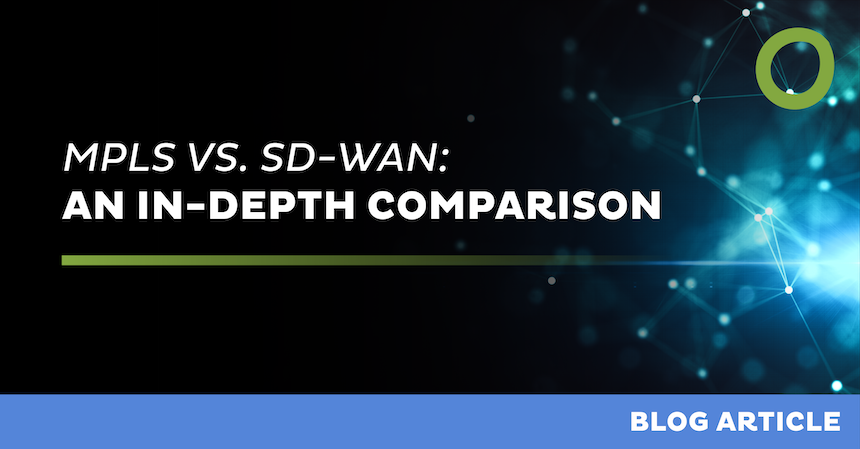
Hybrid Network Infrastructure: SD-WAN and MPLS Complementation vs Competition


The debate concerning SD-WAN (Software-Defined Wide Area Networking) and MPLS (Multiprotocol Label Switching) as viable solutions for hybrid network infrastructure continues to gain traction. As organizations grapple with increasing demands for agility, security, and cost-efficiency, understanding the nuances of these networking technologies and how they can work together, is imperative. This article provides an overview of the usage of SD-WAN and MPLS as well as an in-depth analysis of their strengths and limitations, helping IT managers and cybersecurity consultants navigate the complexities of hybrid networking.
The Landscape of Hybrid Networking
Hybrid networking has emerged as a strategic approach to managing diverse network requirements. It integrates multiple connectivity technologies – MPLS or internet – to optimize performance, enhance security, and reduce costs on network level. In this context, SD-WAN – as the overlay – and MPLS – as part of the underlay – play pivotal roles, each offering unique capabilities that cater to specific organizational needs. SD-WANs running on a hybrid connectivity layer with a strategic mix of MPLS and internet access lines have become networking best practice for many organizations.
Understanding MPLS
MPLS is a well-established connectivity technology renowned for its reliability and performance. It operates by directing data packets along predetermined, high-priority pathways, ensuring consistent data delivery with minimal latency. This makes MPLS particularly suited for mission-critical applications that demand high levels of performance and reliability.
Strengths of MPLS
- Quality of Service (QoS): MPLS excels in providing QoS on connectivity level, allowing organizations to prioritize traffic and ensure bandwidth is allocated to critical applications.
- Consistency: The technology’s ability to deliver a stable and predictable performance is crucial for applications requiring real-time data transmission.
- Service Level Agreements (SLAs): Providers offer SLAs that guarantee the availability and quality of MPLS connections.
Limitations of MPLS
- Cost: MPLS can be prohibitively expensive, particularly for organizations with expansive and complex network requirements.
- Scalability: Adapting MPLS to accommodate new locations or increased bandwidth demands can be a slow and costly process.
- Flexibility: The rigidity of MPLS circuits can limit an organization’s ability to quickly adapt to changing network requirements.
The Emergence of SD-WAN
SD-WAN represents a paradigm shift in networking, leveraging software to manage network operations and traffic routing dynamically. It abstracts the connectivity layer – internet or MPLS circuits – as well as network hardware and uses centralized control to intelligently direct traffic across the WAN.
Strengths of SD-WAN
- Agility: Its software-driven approach allows for rapid deployment and adaptation to changing network demands, facilitating scalability.
- Security: Advanced SD-WAN solutions incorporate robust security features, such as end-to-end encryption and integrated threat protection.
- Performance Optimization: By using real-time analytics and traffic management, SD-WAN ensures optimal application performance and user experience.
- Cost Efficiency: SD-WAN can reduce reliance on costly MPLS circuits by utilizing broadband internet connections, leading to significant cost savings.
Limitations of SD-WAN
- Complexity: Implementing SD-WAN can be complex, requiring significant expertise to configure and manage effectively.
- Internet Dependency: While it reduces costs, relying on internet connections can introduce variability in performance compared to dedicated MPLS circuits.
- Missing Performance Guarantees: Many SD-WAN providers can’t abstract network availability and performance in a meaningful way and hence, don’t offer SLAs.
- Security Concerns: Despite advanced security features, SD-WAN solutions can be vulnerable if not properly configured and monitored.
SD-WAN vs MPLS: A Comparative Analysis
When evaluating SD-WAN and MPLS for hybrid network infrastructure, several factors must be considered, including cost, performance, security, and scalability.
Cost Considerations
MPLS is traditionally more costly due to its reliance on dedicated circuits. In contrast, SD-WAN can leverage less expensive internet connections, offering a more cost-effective solution for organizations seeking to optimize their connectivity expenditure.
Performance Metrics
For applications requiring high reliability and low latency, MPLS remains the gold standard. However, SD-WAN’s ability to dynamically route traffic and optimize performance through intelligent path selection can closely match MPLS performance under certain conditions.
Security Posture
MPLS provides a basic level of security by maintaining traffic within private networks – separating data from labels – but doesn’t protect information from being sniffed by the provider. SD-WAN, however, has evolved to offer sophisticated security measures, including encryption and integrated threat protection, making it a formidable contender in secure networking.
Scalability and Flexibility
SD-WAN’s inherent flexibility and ease of deployment make it highly scalable, accommodating new locations and increased bandwidth demands with relative ease. MPLS, while reliable, lacks the agility required for rapid scalability.
Crafting a Hybrid Network Strategy
For organizations seeking to leverage the strengths of both SD-WAN and MPLS, a hybrid network strategy can offer the best of both worlds. By integrating these technologies – SD-WAN which is built on a hybrid connectivity layer with internet and MPLS circuits, enterprises can achieve a balance between cost-efficiency, performance, and security.
Key Considerations for Hybrid Networking
- Assessing Network Requirements: Understand the specific needs of your organization, including application performance, security, and budget constraints.
- Evaluating Vendor Solutions: Choose vendors that offer comprehensive solutions capable of integrating MPLS and SD-WAN seamlessly.
- Implementing Security Protocols: Ensure robust security measures are in place, particularly when integrating internet-based connections.
- Continuous Monitoring and Optimization: Regularly assess network performance and adjust configurations to maintain optimal efficiency and security.
Conclusion
Companies don’t have to choose between SD-WAN and MPLS but rather have to identify how to combine them, so they complement each other: hybrid network infrastructure is not a matter of one-size-fits-all. Each technology offers distinct advantages and challenges that must be weighed against the specific needs and goals of an organization. By understanding these dynamics and strategically integrating both SD-WAN for networking and MPLS for connectivity, enterprises can craft a robust, flexible, and secure network infrastructure that supports their digital transformation journey.
The expertise of seasoned IT managers and cybersecurity consultants is invaluable. Navigating the intricacies of hybrid networking requires a strategic approach, a deep understanding of technological nuances, and a commitment to ongoing optimization and security. The future of networking is hybrid, and mastering this landscape is key to sustained digital success.
Leave Complexity
Behind
To learn how Open Systems SASE Experience can benefit your organization, talk to a specialist today.
Contact Us



